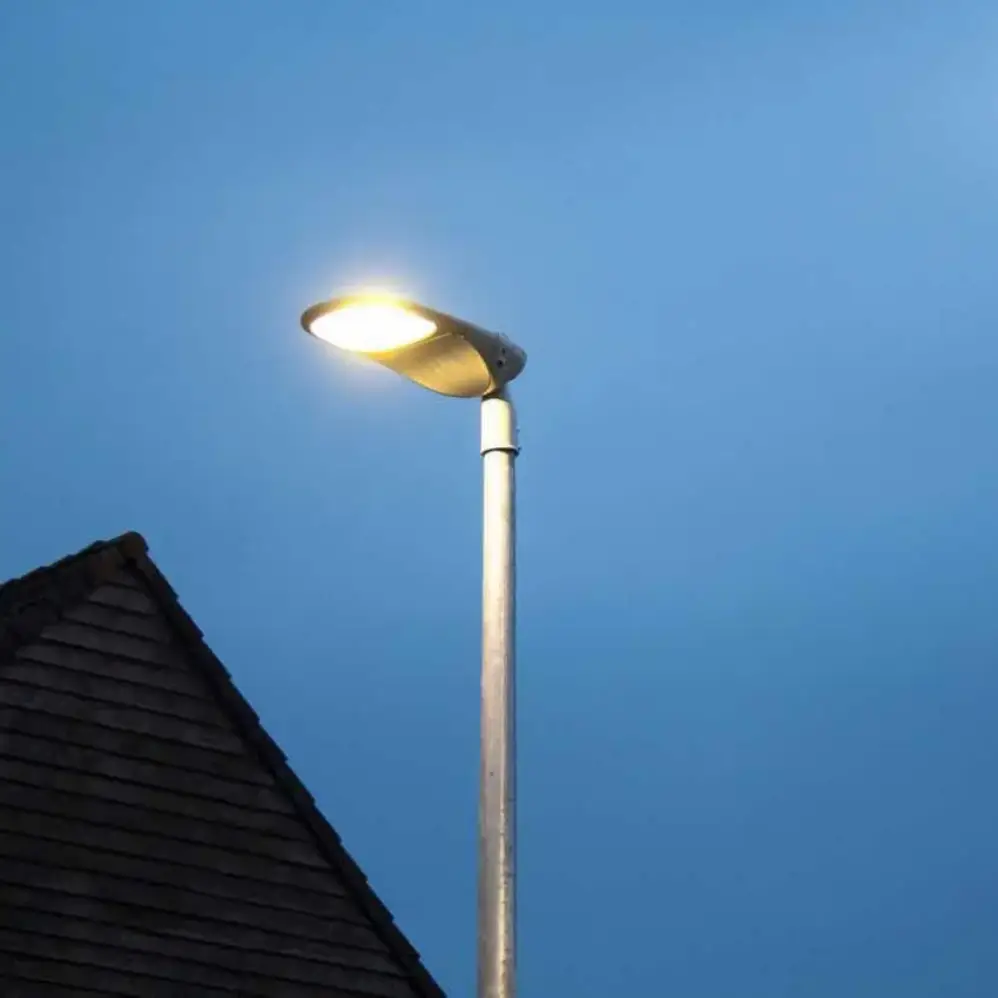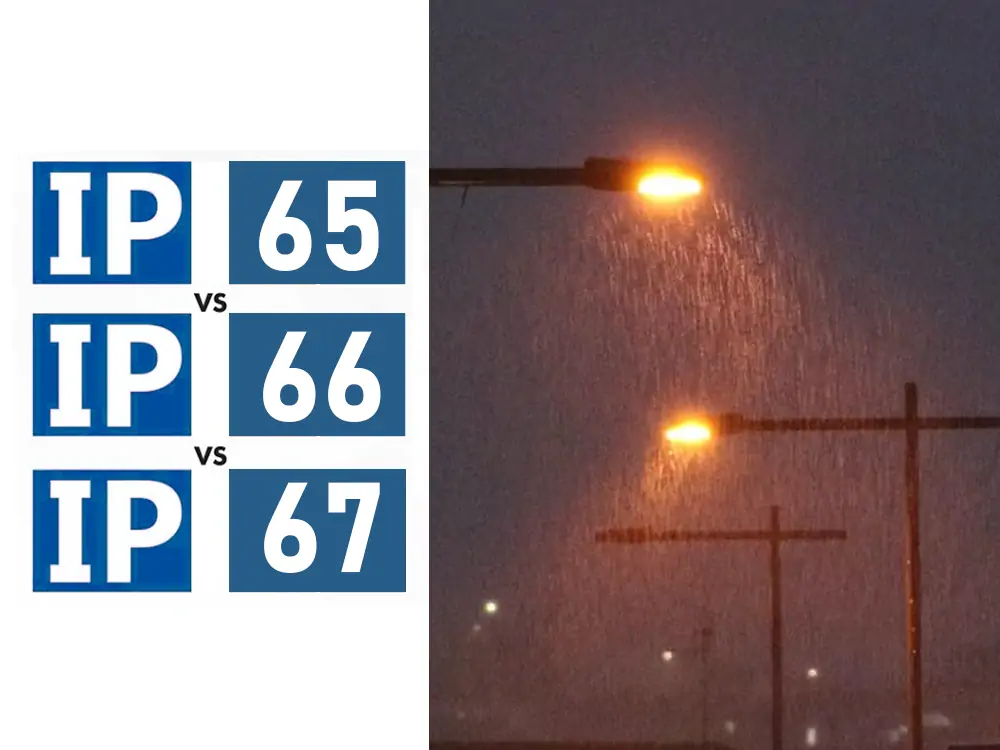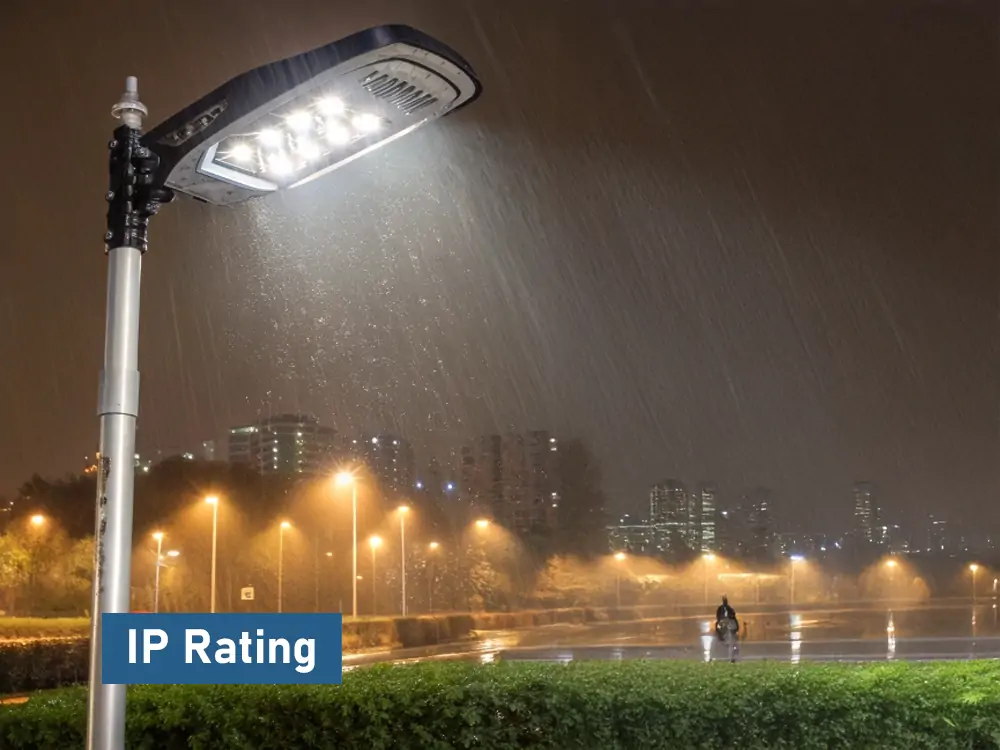When choosing outdoor lights, understanding the IP rating system is paramount. Why? Because Outdoor lights remain under the stress of harmful environmental conditions. Consistent dust, debris, and rain exposure can negatively impact the lights. The common IP ratings IP65 VS IP66 VS IP67 indicate how safe lights are against dust and moisture.
Unfortunately, many people don’t understand the IP rating system. As a result, they end up buying lights that are not waterproof. During the rainy season, such lights can become faulty, ruining the money. However, don’t worry if you also don’t know IP ratings. This article will discuss everything about IP rating and its three common grades.
What is the IP Rating & its Meaning for Outdoor Lights?

IP stands for Ingress Protection rating. It indicates how safe a product is against moisture and dust. It is generally a safety standard for electronics such as lights and other products. The International Electrotechnical Commission (IEC) defines this rating or standards.
Simply put, this rating indicates different protection levels against dust and water. This rating system is indicated by ‘IP’ followed by two numbers, for example, IP64, IP65, and IP67. These two numbers or digits hold the key importance. How? The first number indicates the protection against solid material, i.e., dust and debris.
The second number indicates the protection of production against moisture or water. Suppose you have an outdoor light with IP65. In this case, the light will have 6-grade dust and 5-grade water protection. The higher the numbers, the greater the protection, and vice versa. Here is a table that shows the level of protection as IP ratings:
Number | Solid Protection | Water Protection |
0 | No protection | No protection |
1 | >50mm objects | Vertical drops |
2 | >12.5mm objects | 15° tilted drops |
3 | >2.5mm objects | Sprays (up to 60°) |
4 | >1mm objects | Splashes |
5 | Dust-protected | Low-pressure jets |
6 | Dust-tight | High-pressure jets |
7 | Dustproof | Immersion (1m) |
The light of IP65 will be dust-tight or proof due to 6 (the first digit). However, only a low-pressure water jet is protected by the number or digit 5. You can refer to the table above to determine which number indicates what level of protection. Remember, each IP rating suggests a different level of dust and water protection.
IP65 VS IP66 VS IP67: Understand Differences
Have you understood the basics of the IP rating system? Each outdoor light has a specific rating, indicating how good it will be in outdoor conditions. Remember, such lights can be exposed to dust, rain, and humidity. Understanding the difference is key. Let’s dive deeper and understand these IP65, IP66, and IP67 ratings.

1- Outdoor Lights with IP65 Ratings
The outdoor lights with an IP65 rating come with optimal protection. The digit 6 indicates that they are dust-tight. It means that no debris or dust will be able to enter them. As a result, they will remain in perfect condition if used in very dusty areas.
The second digit, 5, indicates that these lights are decently protected against water. They can withstand a low-pressure water jet. Don’t be confused by a water jet and assume it is water spray. You can refer to the IP rating table above to understand their value. In short, these lights suit urban areas where dust is common.
They won’t get damaged by the gentle rain. You can use them in gardens, patios, driveways, and building exteriors. Interestingly, outdoor lights with an IP65 rating come in different designs and styles. This gives you multiple authorities to choose from. Keep the combination of lighting and aesthetics appealing when choosing outdoor light.
2- Outdoor Lights with IP66 Ratings
Outdoor lights with an IP66 rating are trendy. The reason is that they offer exceptional durability. The IP66 means they have grade 6 for both dust and water protection. It means that these lights are perfectly sealed. No dust particles and debris won’t be able to enter them.
On the other hand, the 6-grade water protection ensures waterproofing. These lights can easily withstand high-pressure water jets or spray. They won’t be affected if they remain exposed to high-pressure water jets for a long time. No moisture will succeed in getting inside these lights. These lights are ideal for use in areas with more frequent heavy rain.
Generally, areas near the oceans are very humid. If you live in damp conditions, you can use it outdoors. These are also suitable options for stadiums, pools, or boating dock platforms. The overall water protection of these lights would be better than those with an IP 65 rating. These lights (IP65 and IP66) are the same regarding dust protection.
3- Outdoor Lights with IP67 Ratings
Do you want outdoor light that doesn’t get faulty upon immersion in water? In such a case, these lights with an IP rating of IP67 suit you. The first digit 6 in the IP rating indicates that they are dustproof. However, their second digit speaks a different truth. How? The second digit indicates the grade 7 level of protection.
This means it won’t be faulty if the outdoor light gets immersed in water at a depth of 1m. You can use them even in extreme weather conditions; they won’t disappoint you. People generally use them in areas where heavy floods are more common. These lights can remain in such areas, face high levels of water immersion, and still perform well.
You can also use them as underwater ponds and poolside lights. Despite water immersion, outdoor lights with IP 66 are more popular than these lights. Because IP 66 lights offer excellent water protection, they are fantastic options for urban areas. Their pricing is also low as compared to these lights. However, IP67 is only suitable if you live where water floods are common.
What is IP Rating & What Does It Mean for Outdoor Lights?

The answer is, “It depends.” There is no single answer to this question. Generally, outdoor lights with IP66 are suitable for most people. They offer excellent dust and water protection. However, IP67 lights can be a decent option if you live where rain storms or floods are common.
Outdoor lights with IP65 come with decent dustproofing. However, their water or moisture protection is not ideal. They can also only withstand low-pressure water spray. Such lights can be a nice option if you need light in normal conditions. However, they will get damaged in extreme rain. However, their price is relatively low, which is a plus point.
The next in line is outdoor lights with IP66. Such lights offer an excellent combination of dust and water protection. They can bear sharp or high-pressure water jets or sprays, making them ideal for use in an open area where they will comfortably face extreme rain. Interestingly, the price of these lights is also optimal—slightly higher than IP65 lights.
Lastly, IP67 is expensive but falls in the premium category. They can withstand water and remain in satisfactory working conditions. But I don’t recommend buying such lights. They are only suitable if you need an extreme level of water protection from the lights. But their pricing is on the higher side. Therefore, you should prefer outdoor lights with IP66. Their dust and water protection justifies their pricing.
Here is a table showing the different applications of each outdoor light of different ratings:
IP Rating | Common Applications |
IP65 | Garden lights, patio lights, pathway lights, driveway lights, Farolas LED |
IP66 | Security lights, floodlights, stadium lights, industrial outdoor lighting |
IP67 | Underwater pond lights, poolside lights, marine, and dock lighting |
Frequently Asked Questions
Which is better: IP66 or IP65 lights?
I consider IP66 lights a superior option over one with an IP65 rating. The reason is that these lights can bear the high-pressure water sprays. It means they can handle heavy rains and storms when used outdoors.
Are IP67 lights better than IP66?
Technically, YES! The 7 grade or level of water protection ensures these lights can be immersed in water for a few minutes. However, I like outdoor lights with IP66 protection. They will perform well in heavy rains and offer the same level of dustproofing as IP67.
What is IP65 IP66 IP67?
IP stands for “Ingress Protection Rating.” It indicates how good a product is regarding dust and water protection. The dustproofing in all these IP ratings is the same and excellent. However, IP65 lags compared to IP66 and IP67. Products with IP67 will be exceptional when facing water.
Which is better: IP65 or IP67?
The IP65 rating indicates slightly compromised water protection. On the other hand, IP67 is perfect. Therefore, I consider lights with an IP67 rating a better option than their counterparts.
Are outdoor lights IP67 fully waterproof?
Yes, the IP67 rating indicates an excellent level of waterproofing. The product with this rating can be immersed in water for a few minutes without getting faulty.
Conclusión
Outdoor lights expose different environmental elements. So, they must be durable to withstand all those elements. If you buy light, understanding its IP rating is crucial. This will help you know how durable your light will be when used in outdoor conditions.
The standard ratings are IP65, IP66, and IP67. This article explained how outdoor lights with these ratings can vary from one another. You should choose the lights with IP66. They offer an excellent balance of lighting, protection, and pricing. Lights with IP67 are also premium options but are very expensive.
